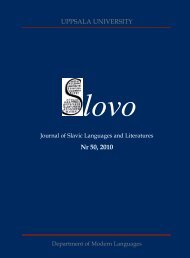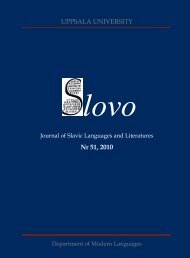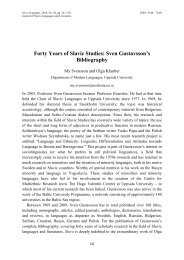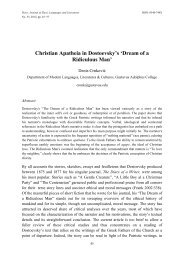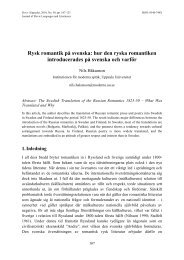Full text PDF - Index of - Uppsala universitet
Full text PDF - Index of - Uppsala universitet
Full text PDF - Index of - Uppsala universitet
You also want an ePaper? Increase the reach of your titles
YUMPU automatically turns print PDFs into web optimized ePapers that Google loves.
Slovo. Journal <strong>of</strong> Slavic Languages and Literatures<br />
No. 52, 2011<br />
Thus, she identifies the only known so far and clearly defined <strong>text</strong>ual family <strong>of</strong><br />
Slavonic liturgical Tetraeuagenlia. In the second volume <strong>of</strong> her book, “A Linguistic<br />
and Textual Introduction”, Vakareliyska precisely characterizes the <strong>text</strong>ual and<br />
linguistic features <strong>of</strong> the common protograph <strong>of</strong> the Curzon Gospel, Banica Gospel,<br />
and Dobrejšo Gospel, referred to as “DBC antigraph for Mark, Luke, and John”.<br />
Further on, she outlines those features which distinguish the Dobrejšo Gospel from the<br />
two other Gospel manuscripts examined. Next, she summarizes the features (<strong>text</strong>ual<br />
version, calendar structure, language, and orthography) typical for the Banica Gospel<br />
and Curzon Gospel antigraph (“BC antigraph”). An important implication <strong>of</strong> this<br />
identification ends with the scholar’s conclusion that, according to the <strong>text</strong>ual<br />
characteristics, the Banica Gospel is “younger” than the more conservative Curzon<br />
Gospel. Moreover, in contrast to the opinion <strong>of</strong> the editors <strong>of</strong> the Banica Gospel, she<br />
suggests that this codex is not likely to have been written in the thirteenth century; 2<br />
rather, it was produced in the fourteenth century when the Curzon Gospel was written.<br />
She correctly points out that these two manuscripts are later than the Dobrejšo Gospel.<br />
Another important result <strong>of</strong> the author’s exhaustive comparison is that both<br />
Lectionary Gospels and Tetraeuangelia were used for compilation <strong>of</strong> the DBC<br />
antigraph. Moreover, in John 11:54, Vakareliyska notices a shift from a more archaic<br />
version (closely related to the early Cyrillo-Methodian translation <strong>of</strong> the Gospel) to a<br />
version which has more Preslav lexical variants. This is another example for a switch<br />
between two <strong>text</strong>ual versions in one manuscript. Her observation on the use <strong>of</strong> the socalled<br />
Preslavisms in the Gospel by John shows, once again, that not all <strong>of</strong> the lexemes<br />
generally accepted to reflect the Preslav lexical redaction, are necessary to appear in a<br />
given source and that they <strong>of</strong>ten coexist with earlier lexical choices (introduced by the<br />
first translators <strong>of</strong> the Gospel). What I would personally avoid is the use <strong>of</strong> the terms<br />
“Ohrid-associated lexicon” and “Preslav-associated lexicon”. I would rather prefer<br />
“early”, or “archaic”, or “Cyrillo-Methodian” lexical stratum versus Preslav lexical<br />
innovations, because the lexical preferences <strong>of</strong> the Preslav literati, at a relatively early<br />
stage <strong>of</strong> the Slavonic Gospel <strong>text</strong> transmission, became widespread both in eastern and<br />
western medieval Bulgarian lands, including the Ohrid region (as well as in mediaeval<br />
Serbian and East Slavonic lands). Albeit these innovations originated in Preslav, they<br />
soon became disseminated in the 10 th -century southwestern Bulgarian territories and<br />
many <strong>of</strong> them appear also in copies <strong>of</strong> <strong>text</strong>s which are believed to have been composed<br />
in Ohrid, such as St. Kliment <strong>of</strong> Ohrid’s original homilies. Even if some <strong>of</strong> the<br />
Preslavisms were not incorporated by St. Kliment himself, they were so deep-rooted in<br />
the literary language that a later editor <strong>of</strong> his homilies could easily be able to replace<br />
the more archaic lexemes with the preferred Preslav ones in the <strong>text</strong>s composed by St.<br />
Kliment.<br />
2 Dogramdžieva, E. & Rajkov, B. 1981: Дограмаджиева, E., Райков, B. Банишко евангелие. Среднобългарски<br />
паметник от XIII век. София.<br />
100



